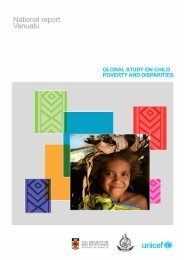A Strategic Assessment of the Children's Services Industry
A Strategic Assessment of the Children's Services Industry
A Strategic Assessment of the Children's Services Industry
- No tags were found...
You also want an ePaper? Increase the reach of your titles
YUMPU automatically turns print PDFs into web optimized ePapers that Google loves.
STRATEGIC ASSESSMENT OF THE CHILDREN’S SERVICES INDUSTRYpercentage <strong>of</strong> total available hours (SCRGSP, 2008, DEEWR, 2008a). The nationalutilisation rate for centre-based long day care in 2006 was 73.9 per cent. This measure wasused by Treasury in 2007. Although accurate as a measure <strong>of</strong> aggregate demand, utilisationrates are a blunt measure which can give a misleading impression <strong>of</strong> ‘slack’ in <strong>the</strong> system. Itcould be, for example, that <strong>the</strong> unused hours in a child care service are hours in <strong>the</strong> earlymorning and late afternoon. Such hours cannot readily be sold to parents, especially givenAustralian parents’ preference for relatively short hours <strong>of</strong> care. Long day care centres areobliged to <strong>of</strong>fer <strong>the</strong>se hours, however, as a condition <strong>of</strong> approval for Child care Benefit. (Andit is important that <strong>the</strong>se hours be available for families that need <strong>the</strong>m, even if centres are notfull to capacity at <strong>the</strong> beginning and end <strong>of</strong> <strong>the</strong> day.)Table 5.1: Commonwealth and State/Territory Government Funded Children’s <strong>Services</strong>(2006)NSW Vic Qld WA SA Tas ACT NT AustCentre-Based LDCplaces available103,229 54,768 75,782 21,977 14,063 4,271 5,272 2,863 282,225Utilisation rate (%) 78.2 70.1 71.2 69.8 72.0 72.4 77.1 75.9 73.9Family Day Care(a) 24,830 16,194 16,204 5,484 6,364 2,732 2,160 1,170 75,138Utilisation rate (%) 63.2 61.2 64.8 60.3 74.9 64.6 52.0 56.3 63.3Demand Determined by Total Available * Utilisation RateCentre-Based LDC 80,735 38,370 53,949 15,349 10,124 3,092 4,063 2,172 208,536Family DayCare(a)15,688 9,917 10,495 3,309 4,767 1,765 1,124 658 47,577Total Demand <strong>of</strong>LDC and FDC96,423 48,288 64,445 18,658 14,891 4,857 5,186 2,830 256,113Current Vacant oravailable placesCentre-Based LDC 22,494 16,398 21,833 6,628 3,939 1,179 1,209 691 73,689Family Day Care 9,142 6,277 5,709 2,175 1,597 967 1,036 512 27,561Source: SCRGSP (2008)Ano<strong>the</strong>r method <strong>of</strong> presenting demand for children’s services is to examine <strong>the</strong> proportion <strong>of</strong>children who are using <strong>the</strong>se services.According to <strong>the</strong> 2006 Australian Government Census <strong>of</strong> Child care <strong>Services</strong> (DEEWR,2008a), <strong>the</strong> estimated number <strong>of</strong> children attending long day care was 420,110, with 80 percent <strong>of</strong> <strong>the</strong> children attending for less than 30 hours a week. As at May 2006 (time <strong>of</strong> <strong>the</strong>Census), 5 per cent and 23 per cent <strong>of</strong> children in long day care centres and family day carerespectively attended school.46
















